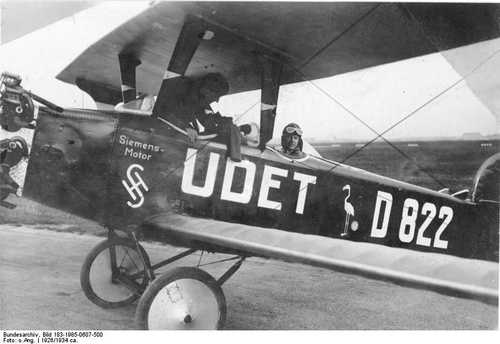
German Leadership
That Magnificent Man in his Flying Machine ...
Bundesarchiv.
Former Oberleutenant, future Luftwaffe Generaloberst Ernst Udet seated in the rear cockpit of a Udet U 12 Flamingo aerobatic biplane, probably late-1920s. The U 12 was a very popular aerobatic platform in the latter part of the 1920s, in large part due to the spectacular use made of it by Udet as an airshow performer in these years. The "SH" logo reflects the fact that these aircraft mounted Siemens-Halske radial engines (SH-11 or, in later models, SH-12). It was probably in an aircraft like this that Udet took his friend, Leni Riefenstahl, up on a hair-raising flight which she described in a postwar interview, the highlight of which was the stunt of diving to withing a few metres of the runway and hovering, motionless, into the wind, like a seagull. Ernst Udet was Germany's second-highest scoring fighter pilot of WW1 (60 confirmed kills) and, in contrast to his reserved - indeed withdrawn and introverted - superior (in rank and in score) the Red Baron (80 confirmed kills), was an outgoing, daredevil bon viveur with definite artistic talent. His popular profile and war hero status made him an attractive recruit to the Nazi Party for another former commanding officer, Hermann Goering, who encouraged the pretty well apolitical Udet to join the Party (1933) in return for support for his aeronautical activities (two Curtiss Hawk II aircraft were purchased and put at Udet's disposal - although they were also used as trial aircraft for future Luftwaffe warplanes). However, his subsequent appointment, as a Luftwaffe General, to the post of Minister for Aircraft Development and Supply was quite out of step with his swashbuckling, artistic character. Udet's lack of interest or competency in bureaucracy or in office/Nazi politics left him vulnerable to rivals such as Erhard Milch, and prone to become a fall-guy for failures to deliver on aircraft development and production targets which were, in fact, unattainable due to shortages of raw materials. The pressures of his situation led to a retreat into depression and drinking, leading in turn to his suicide in December, 1941. The suicide was covered up, with typical thoroughness, by the Gestapo. The populace were told that Udet had died, heroically, conducting a test flight on an experimental aeroplane. Best regards, JR.
2872 Views
7/13/2012
